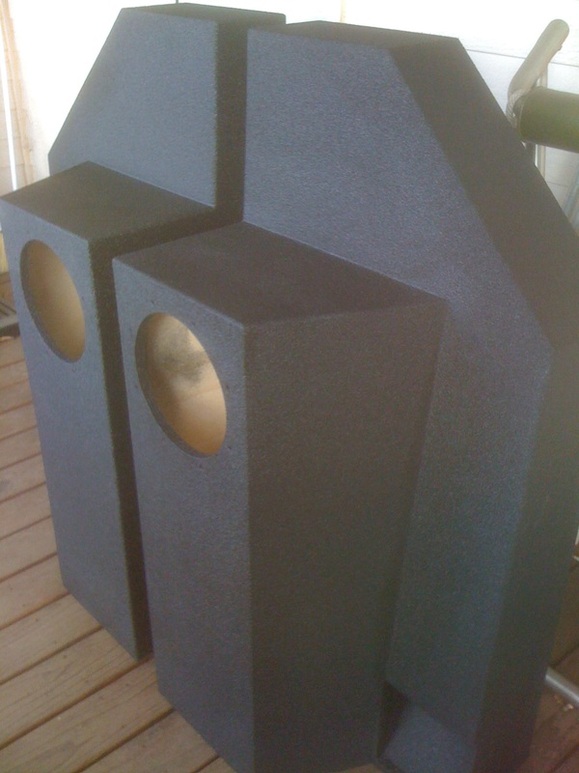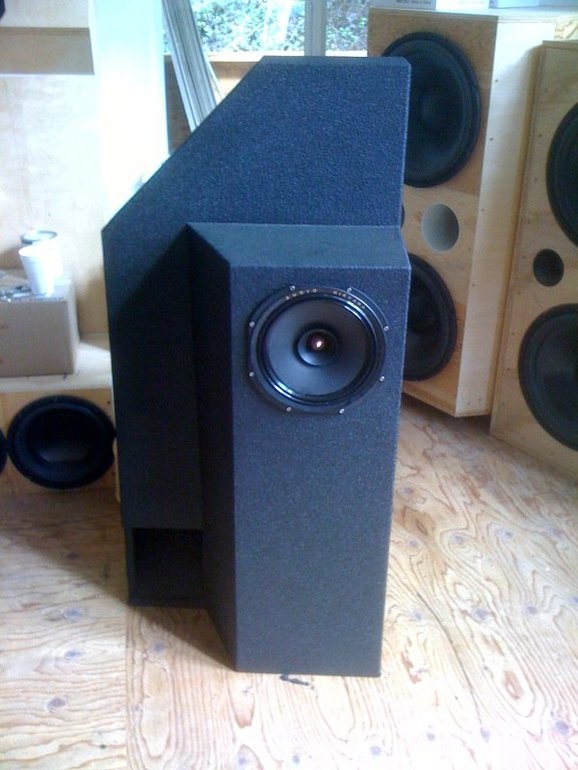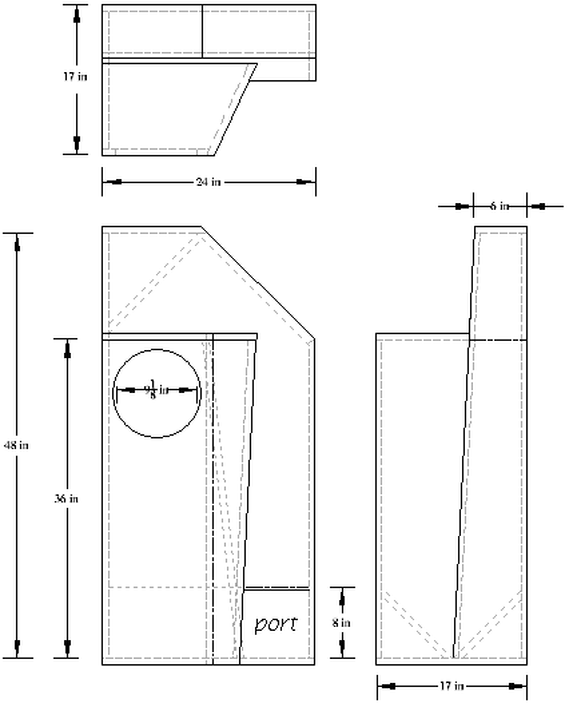Audio Nirvana full range driver
In the top picture, you can see a transmission line enclosure loaded with an Audio Nirvana Cast 10 driver. In the lower picture, you see the folding in the T/L -- it's roughly twelve feet in length, and if you look closely, you'll notice that it tapers. The initial area surrounding the driver is twice that of the cone. By the time the line exits the port (lower left in the top pic) it's the same area as the cone. Parallel walls are non-existent--this prevents those one note booms--there's a slanting inner baffle which creates the taper and prevents the outer side-walls from generating standing waves. The front wall has a gentle slope to further the non-parallel wall effect.
The line is dampened with dacron fluff immediately behind the driver, but nowhere else.
Obviously, they are built using the "book-ends" technique.
I love the sound this combination creates. Being full range, the stereo imaging is fantastic. Because the driver is efficient (roughly 96 db 1W1M) a low wattage amplifier-- like my class A amp ;^) -- is more than sufficient to fill a room with sweet, detailed music. When listening to a stereo pair, you will hear not only left to right, and top to bottom, you'll hear depth. It's this depth that excites me most of all. I listened to a well recorded drum solo from a favorite CD and could literally hear the semi-circle arrangement of the drum set. Just as impressive, the cone barely quivered. I had Xmax to spare. It was, without a doubt the most impressive display of three dimensionality and headroom I've ever witnessed, and excited me to a condition I affectionately call "wet eyes". We men like to think we're a tough breed, don't cry and all that stuff -- maybe so, but when the chorus is just right and the high notes are transparent, I do get the occasional case of "wet eyes" ;^)
Ahemm...
I added an EQ to the mix to boost/contour the bottom end a bit. An RTA display offered proof that the output stayed flat from 40 hz to 18K hz. That's pretty darned impressive for a single driver. If you want to avoid the EQ, just add a sub and cross it at 40hz. You'll have a truly amazing time and won't have to miss out on that amazing 3-D full range quality because the full range driver is still carrying the vast majority of the sound spectrum.
Horns and open baffles used to be my first choice in musical reproduction, but I find more and more that I prefer to listen to the T/L Audio Nirvana arrangement for casual listening. The horns are more desirable for those days when I need a healthy dose of SLAM, or to back up a really good action movie.
Should you wish to explore this sweet adventure further, then hyper-jump over to http://www.commonsenseaudio.com where you can find a decent selection of full range drivers. Tell David Dicks (the owner of that web site) that John Inlow sent you. David's a friendly fellow with plenty of opinions and candor to share. You can't go wrong with a combination like that.
If you wish to purchase a full set of prints to this enclosure, the fee is $25.00. I'll warn you in advance, this is a difficult enclosure to build. You should have a bit of woodworking experience.
The line is dampened with dacron fluff immediately behind the driver, but nowhere else.
Obviously, they are built using the "book-ends" technique.
I love the sound this combination creates. Being full range, the stereo imaging is fantastic. Because the driver is efficient (roughly 96 db 1W1M) a low wattage amplifier-- like my class A amp ;^) -- is more than sufficient to fill a room with sweet, detailed music. When listening to a stereo pair, you will hear not only left to right, and top to bottom, you'll hear depth. It's this depth that excites me most of all. I listened to a well recorded drum solo from a favorite CD and could literally hear the semi-circle arrangement of the drum set. Just as impressive, the cone barely quivered. I had Xmax to spare. It was, without a doubt the most impressive display of three dimensionality and headroom I've ever witnessed, and excited me to a condition I affectionately call "wet eyes". We men like to think we're a tough breed, don't cry and all that stuff -- maybe so, but when the chorus is just right and the high notes are transparent, I do get the occasional case of "wet eyes" ;^)
Ahemm...
I added an EQ to the mix to boost/contour the bottom end a bit. An RTA display offered proof that the output stayed flat from 40 hz to 18K hz. That's pretty darned impressive for a single driver. If you want to avoid the EQ, just add a sub and cross it at 40hz. You'll have a truly amazing time and won't have to miss out on that amazing 3-D full range quality because the full range driver is still carrying the vast majority of the sound spectrum.
Horns and open baffles used to be my first choice in musical reproduction, but I find more and more that I prefer to listen to the T/L Audio Nirvana arrangement for casual listening. The horns are more desirable for those days when I need a healthy dose of SLAM, or to back up a really good action movie.
Should you wish to explore this sweet adventure further, then hyper-jump over to http://www.commonsenseaudio.com where you can find a decent selection of full range drivers. Tell David Dicks (the owner of that web site) that John Inlow sent you. David's a friendly fellow with plenty of opinions and candor to share. You can't go wrong with a combination like that.
If you wish to purchase a full set of prints to this enclosure, the fee is $25.00. I'll warn you in advance, this is a difficult enclosure to build. You should have a bit of woodworking experience.
Mirror image:

Bookend style. I reversed the prints on one of the T/L enclosures and created a mirror image. The course, polyurethane finish is actually spray-on truck bed liner. Anything to avoid the humdrum, right?

